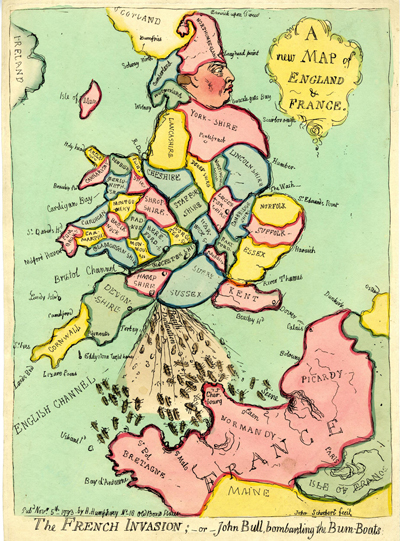The French Invasion,
or John Bull Bombarding the Bum-Boats
Not suprisingly, this print with its crude humor and explosively alliterative subtitle was one of those that offended the delicacy of Victorian sensibilities. As a result, it was relegated to the second volume of the Bohn edition with forty-four other so called "Suppressed Plates," devoted to fornication, flagellation, and defecation, and passed over in the commentaries by Wright, Evans, and Grego. It shows John Bull, i.e. King George III, embodied as a map of England, fending off a somewhat pathetic attack of French rowboats by farts and turds issuing from his own "bum." Those are the weapons, rather than actual guns and boats, that Gillray labels "British Declaration."

[November 5, 1793]
© Trustees of the British Museum
The print was published in November of 1793 after the French execution of the King Louis XVI in January, and the subsequent declaration of War on England on February 1st. But the immediate political impetus was likely to have been the short and toothless "British Declaration" delivered in Parliament by King George himself on October 29, 1793. (Full text linked below.) As Prime Minister William Pitt was later to acknowledge, Engand was fundamentally unprepared for a war in 1793. Through his Secretary of State for Foreign Affairs, William Grenville, Pitt had from the first been reaching out to get better equipped allies like Austria, Prussia, and Spain to do most of the actual fighting for Britain against France. As a result, though replete with good intentions and vague demands, the British Declaration reads very much like someone eager to avoid fighting who hopes that counter-revolutionaries within France and Britain's allies outside of it will take care of Britain's business for him.
Gillray appears to have been less sanguine about that. The print is signed John Schoebert which most people take as one of many Gillray aliases. According to Google, "Schoebert" derives from the middle high German word for shoemaker or cobbler. That may suggest an oblique comment upon the way Pitt and Grenville have cobbled together their resistance force both at home and abroad. But the fact that Gillray's map also shows King George wearing a fools cap formed by Northumberland is certainly the strongest evidence that Gillary is not convinced of the wisdom of this approach. However disdainful of the French naval forces themselves and the threat of any real invasion, Gillray seems to think a war built upon bluster and BS is foolish.
Maps in the 18th century were popular and indeed often necessary as frequent wars involving Britain and Europe altered borders and made a thorough knowledge of roads and topography an essential strategic weapon. They were often published and sold by the same vendors who supplied prints to both serious and satiric markets. Some of the print-sellers who also sold maps included John Bowles (later Carington Bowles), Laurie and Whittle, Robert Sayers, and Robert Wilkinson.
Gillray had already been involved, at minimum as an etcher, in a print entitled Britannia where a map of England was imagined as an aging Britannia holding her trident while riding a sea creature. But it is likely that the current print was conceived as a parody of the beautiful Map of England and Wales by John Bowles which Gillray could have seen at the shop of his friend and collaborator, Robert Wilkinson, who had taken over Bowles's inventory upon that gentleman's death in 1779. The colouring is similar to the Bowles map as is the title insignia. Wilkinson issued a minor update to the map in 1793, and it is also possible that Gillray's plate was designed as a reminder of the importance of maps in wartime and as a subtle plug for Wilkinson's update.*
* Many thanks to Mathew Crowther, the author of the excellent web site The Printshop Window (from whom I have learned a lot) for alerting me to the Bowles map as a potential source for The French Invasion. . . .
Sources and Reading
- Commentary from the British Museum on The French Invasion, or John Bull Bombarding the Bum-Boats.
- Draper Hill, Mr. Gillray The Caricaturist, 1965,p. 46n, 53.
- "1793 Wilkinson Map of England and Wales," Geographicus
- "Bumboat," Wikipedia
- "King's Declaration, October 1793," Cobbett's Parliamentary History
- "Mapmaker Biographies," Daniel Crouch Rare Books
- Robin Reilly, William Pitt the Younger, New York, 1979, pp. 275-288.
- "War of the First Coalition," Wikipedia
Comments & Corrections
NOTE: Comments and/or corrections are always appreciated. To make that easier, I have included a form below that you can use. I promise never to share any of the info provided without your express permission.